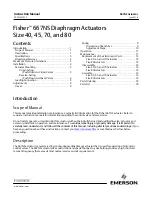
Instruction Manual
D102603X012
667NS Actuator
June 2018
8
7. Increase actuator loading pressure to the upper end of the bench range and check to be sure that the mark on the
actuator stem is in line with the top mark on the travel indicator scale.
If the marks are in line,
the actuator is properly bench set.
If the marks are not in line,
the spring is not correct for the specified bench set. It is necessary to use a different spring
or a different bench set.
CAUTION
Do not clamp just the tip of either the valve stem or the actuator stem in the stem connector. Incomplete engagement of
the valve stem and/or actuator stem in the stem connector might result in stripped threads or improper operation. Be sure
that the length of each stem clamped in the stem connector is equal to or greater than the diameter of that stem.
8. Pull the valve stem firmly against its seat, and be sure that it remains firmly against the seat. Clamp the actuator
stem and valve stem between the two stem connector halves.
If necessary, decrease actuator loading pressure slightly to allow the valve stem, actuator stem, and stem connector
threads to match.
Insert and tighten the stem connector cap screws.
WARNING
To avoid personal injury due to the sudden uncontrolled movement of parts, do not loosen the cap screws when the stem
connector has spring or loading pressure force applied to it.
9. Raise the travel indicator disk to the stem connector (sizes 40 through 70 only). For all sizes, thread the stem
locknuts against the stem connector.
10. Remove all actuator loading pressure. Move the travel indicator scale so that the indicator disk (or pointer) is in line
with the bottom mark of the travel indicator scale.
11. Check the valve travel to be sure that the valve travels fully with no overtravel.
Loading Connection
1. Connect the loading pressure piping to the NPT internal connection in the top of the actuator yoke.
2. For size 70 actuators, remove the 1/4‐inch bushing in the 1/2 NPT internal connection to increase connection size, if
necessary. Use either piping or tubing.
3. Keep the length of tubing or piping as short as possible to avoid transmission lag in the control signal. If an
accessory (such as a volume booster or valve positioner) is used, be sure that the accessory is properly connected to
the actuator. Refer to the positioner instruction manual if necessary.
4. Cycle the actuator several times to check that the valve stem travel is correct and that the travel occurs when the
correct pressure range is applied to the diaphragm.
5. If valve stem travel is incorrect, refer to the Travel procedure in the Adjustments section.
6. If the pressure range is incorrect, refer to the Spring procedure in the Adjustments section.









































